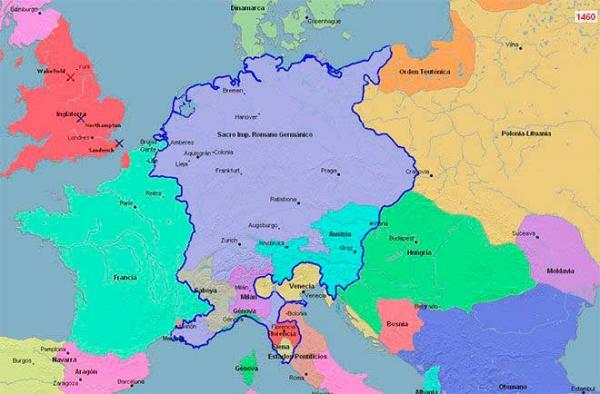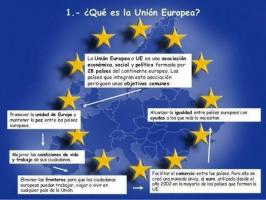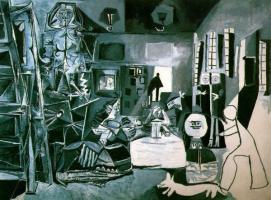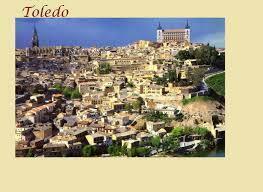Holy Roman German Empire

Image: Universal History
The Holy Roman German Empire It was one of the three kingdoms into which the Carolingian Empire was divided after the Treaty of Verdunin 843, these three kingdoms were Germania, France, and Lotharingia. On the territory that corresponded to Luis the Germanic, the kingdom of Germania was established, which in turn, it was divided into several autonomous duchies: Lorraine, Swabia, Saxony, Franconia and Bavaria
In this lesson from a PROFESSOR we are going to discover one of the kingdoms in which the Carolingian Empire was divided. Keep reading and discover a summary of the Holy Roman Empire to be able to study perfectly and, thus, prepare your exam.
Index
- Origin of the Holy Roman Empire
- The Holy Roman Empire and the Saxon dynasty (962–1064)
- The Francona dynasty (1024–1138) and the Swabian (1138–1250)
- The Habsburgs and the end of the Holy Roman Empire (1273 - 1806)
Origin of the Holy Roman Empire.
The Carolingian kings of Germania faced a series of problems as, at that time, the Germania territories were constantly threatened by invasions by Normans, Hungarians, and Slavs. Also his power underwent a process of weakening in front of the great nobles who dominated the kingdom.
When Louis IV the Child died, the last king of the Carolingian Empire, the most powerful nobles of the kingdom proclaimed as the new monarch of Germania Henry I of Saxony, who tried to secure his power in opposition to the grand dukes. On his death, he named his son as his successor. Otto I in the year 936, known asor The Great for his great conquests and the founding of the Holy Roman German Empire.
The term "sacrum" is given because it was a christian empire that gave birth to the idea of Christianity and Germanic because its base was the kingdom of Germania.
The Holy Roman Empire and the Saxon dynasty (962–1064)
We continue talking about Holy Roman Emperors. Otto I defended his kingdom from invasions and stopped the ambitions of the nobility, which is why in 962 he was proclaimed emperor. In this way the Holy Roman Empire was born which lasted until 1806 as an attempt to recover the Western Roman Empire.
Otto I's main concern was to impose his authority over the nobility, but they refused. The nobles tried to seize land and property from the Catholic Church of Germania, causing a conflict between both groups; in this way, Otto took the opportunity to side with the Catholic Church offering him military aid, money and lands, in exchange for the Church helping him in the administration of the kingdom and the army. In this way the bishops became the officials of the State.
With the support offered by the Church, Otto defeated the Hungarians in the Battle of Lech (955), he stopped the invasions of the Normans and Slavs and managed to impose on the German nobility. In the year 961 Otto intervened in Italian politics in protection of papal authority proclaiming himself king of Italy after defeating King Berengar II.
A year later, in 962, Pope John XII crowned “emperor of the romans”To Otto I, beginning the Holy Roman German Empire. Otto's successors assumed the authority to appoint the Pope and the election of bishops in the way that the Church was subjected to imperial power. Otto spent the last years of his life in Italy until he died in 973.
With Otto II (973 -983) the strengthening of royal power continues, but this task was not easy since Dukes, conquered monarchs, Slavs, and Hungarians awaited their opportunity to to rebel. Otto III strengthened the ties between the Empire and the Papacy and named Rome the capital of the empire.

Image: Universal History
The Francona dynasty (1024–1138) and the Swabian (1138–1250)
It was the relief to the Saxon dynasty. With it, the Holy Roman Empire expands, conquering Hungary, Provence and Burgundy and it is a stage that is characterized by break relations with the papacy, so that the emperors endowed themselves with theological powers and tried to control the entire German Catholic Church.
In 1075 the Investiture complaint, a political and religious problem that pitted Pope Gregory VII and Emperor Henry IV for control of the world. The conflict was resolved in 1124 with the signing of the Concordat of Worms in which the emperor renounced the investiture and accepted the free choice of bishops.
In 1138, the Swabian dynasty assumes the Holy Roman Empire. In this period, Emperor Frederick I Barbarossa stands out, who pacified the Guelphs by granting them the Duchy of Saxony and was defeated by the Lombard league in their attempt to control North of Italy.
The Habsburgs and the end of the Holy Roman Empire (1273 - 1806)
The Habsburgs ruled the empire from 1273 with Rudolph I that annexed Austria to the empire but, little by little, the empire was declining in the face of the power of the great European national monarchies, papal indifference and the particular interests of the states Germans.
The last Holy Roman Emperor was Francis II who undid the empire because he didn't want to see Napoleon name himself as Holy Roman Emperor.
In this video of a PROFESSOR we discover the the fall of the Roman empire and the entry of the Visigoths.
If you want to read more articles similar to Holy Roman Empire - Summary for Study, we recommend that you enter our category of Story.



